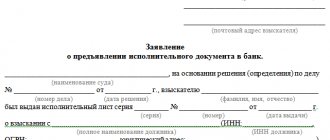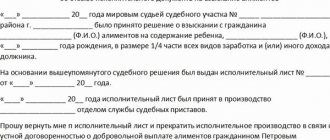A writ of execution: what is it, when is it issued, how is it executed?
When a dispute arises that cannot be resolved amicably, the only chance to resolve it is to go to court.
But if the one who made the demands wins in court, the matter does not end with a decision.
The key problem lies in one simple fact - the decision made by the court must be executed.
For these purposes, there is a separate proceeding, which is called “executive”, and the leading state body that is responsible for enforcement is the enforcement body, which is popularly called the bailiff service.
Therefore, when a court decision receives legal force, this is not enough. It needs to be able to be done.
To do this, the claimant needs to obtain a special document called a “writ of execution”.
We will talk about enforcement proceedings in general and the writ of execution in particular.
What is a writ of execution in simple words?
A writ of execution is a special document that contains the final decision on a case considered in court, be it the collection of alimony, credit debt, fine payments, material and moral damage, and the like.
Simply put, this document contains the effective part of the court decision made in the case.
Form of writ of execution
The writ of execution is a document of strict accountability and is printed on a special form with unique identification marks (number and series).
In addition, it is stitched and certified by the signature of the judge who made the decision on the case considered.
How to obtain a writ of execution in an arbitration court
To obtain a writ of execution in an arbitration court, you need to submit an application with the corresponding content to the office of the judicial authority.
How to draw up an application for the issuance of a writ of execution to the arbitration court
An application to the arbitration court is drawn up similarly to an application submitted to a court of general jurisdiction. The only difference is the timing of the document issuance. In the arbitration court, the IL can be issued the very next day.
The document must indicate:
- name of the judicial authority;
- details of the plaintiff and defendant;
- information about the statement of claim and the decision made;
- statement of the request for the issuance of a document;
- date of application and signature of the applicant.
Sample application for the issuance of a writ of execution to the arbitration court
The procedure for issuing a writ of execution by an arbitration court
The procedure for issuing IL by an arbitration court consists of the following stages:
- Waiting for the date of entry into force of the decision. For acts of arbitration courts of first instance, this period is 30 days. If the verdict has been legally appealed, the decision comes into force on the day the consideration of the case is completed and the relevant decision is issued.
- Submit an application to the court of first instance requesting the issuance of IL.
- Obtain IL from the employee responsible for issuing it.
To draw up a writ of execution, a special numbered form is used. The document is certified by the signature of the judge and the seal of the judicial authority. It is issued in one copy. The following cases may be an exception:
- the obligations of several defendants are subject to recovery;
- recovery is made in favor of several plaintiffs;
- it is necessary to execute a court decision in several places simultaneously;
- collection is carried out from several joint debtors.
When issuing several copies of a document to the IL, it must be indicated in what part, in what amount, from whom and in whose favor the recovery should be made. If it is necessary to collect from joint debtors, it is necessary to indicate the existence of joint and several liability.
Attention! The plaintiff can receive the IL in person or through his representative. The document can be issued directly to the applicant, sent to him by post or transferred to the bailiff service.
Deadline for issuing a writ of execution by the arbitration court
The deadline for issuing IL in arbitration proceedings is not established by law. As a rule, the speed of the procedure depends on the workload of the employees responsible for drawing up the documents. Usually this period does not exceed 5 – 15 days.
Often, the ability to fulfill the requirements set out in it depends on the speed of issuing IL. If there is a delay, unscrupulous debtors may use this time to hide their property or take other measures aimed at making enforcement proceedings impossible. Therefore, if the issuance of a document has been delayed for a long period, it is recommended to submit a written request to obtain information about the degree of readiness of the IL or to file a complaint with the chairman of the court.
Where to submit a writ of execution from the arbitration court
After receiving the writ of execution, the document should be sent to collect obligations from the defendant to the destination, which depends on the status of the debtor:
- If the debtor is a legal entity or individual entrepreneur, you should contact the bank where he has a current account, or the FSSP branch at the defendant’s place of residence or the location of his property.
- If the payer is a government organization, the documents should be submitted to the regional branch of the Federal Treasury at the location of the defendant.
Attention! At the request of the claimant, the writ of execution may be left without presentation.
Writ of execution and bailiffs
As already discussed above, the bailiff service is called upon to carry out the actual implementation of the court decision, in accordance with the Law “On Enforcement Proceedings” dated October 2, 2007 N229-FZ (hereinafter referred to as Law N229-FZ).
At the same time, special officials - bailiffs - work on the enforcement case.
Bailiffs are people in office
When a claimant applies to a bailiff with a writ of execution, he initiates an enforcement case and notifies the debtor of this by sending a copy of the relevant resolution.
The basis for initiating a case is precisely the writ of execution.
Next, the bailiff carries out procedural actions for the debtor to fulfill his obligations. Initially, the debtor is given a period to voluntarily pay the funds. The deadline for execution on a voluntary basis is 5 days. If during the specified period the debtor ignores his obligations, then the executor forecloses on his property. The most popular way to enforce court orders is to send a copy of the writ of execution to the employer.
Thus, the head of the enterprise receives the bailiff’s order, and from that moment on he is obliged to comply with it.
If the employer does not do this, then appropriate liability (both administrative and criminal) may be imposed on him for this.
If the debtor does not work, then in this case the collection will be directed to the money that he has in bank accounts or deposits.
If there are none, then in this case there is only one way out - an inventory of existing property in order to transfer it to the claimant or sale at auction in order to cover the debt.
Sending a writ of execution by the court
Sometimes the court submits the writ of execution to the relevant authority. In this case, the executor independently initiates legal proceedings without filing an application from the claimant. This situation is possible if:
- Recovery of damages that were caused during the commission of a crime is carried out.
- When collecting state duty.
- When collecting alimony.
- When reinstating illegally dismissed employees.
- For complaints about the activities and decisions of government bodies.
The application and the writ of execution are submitted to the bailiff no later than 3 days after it is received by the bailiff body. The duties of the bailiffs are, within 3 days after receipt of the sheet, to issue a decision on the commencement of enforcement proceedings or to submit a refusal.
The debtor can execute the court order 5 days after the receipt of the writ of execution; if he does not do this, payments will be made forcibly.
Payment according to writ of execution
As mentioned just above, the debtor can voluntarily, within 5 days from the moment he became aware of the opening of an enforcement case against him, comply with the decision of the court, without waiting for forced execution.
We are talking about payment according to the writ of execution
If the debtor does not want to fulfill what is prescribed voluntarily, then in this case the procedure for forced collection comes into play.
According to the law, the execution of a court act must be carried out within 2 months.
At the same time, how will the requirements be fulfilled, i.e. Whether the debtor carries the funds in a lump sum or at a certain frequency (as in the case of alimony) does not matter.
As stated earlier, bailiffs have the right to collect debt from the funds available to the debtor, from which collection is possible by law, i.e. with the exception of those specified in Article 101 of Law N229-FZ .
Thus, collection is possible from all the debtor’s deposits, from all his current accounts, from his plastic cards, including credit cards (only if the balance is positive).
If the debtor has accumulated a debt under a writ of execution, then the amount of monthly deductions from wages can amount to 50-70% of total income.
There are situations in which the bailiffs do not detect any available funds from the debtor. It is also a common situation when the debtor does not have official employment and official income.
Then a procedure for confiscation of property is initiated in order to pay off the debt.
The bailiff service has the right to go to the debtor’s living space, describe the property and sell it at auction.
If, after the sale of the property and payment of the debt to the collector and the enforcement fee to the enforcement service, there are funds left, they will be returned to the debtor.
At the same time, a debtor who has a long-term obligation for enforcement proceedings and changes his place of work should take into account that the obligations do not terminate. Therefore, to prevent the debt from increasing due to late repayment, the debtor needs to look for a new employer as soon as possible.
Bailiffs have the authority to submit requests to various organizations to search for debtors (tax authorities, banks, Pension Fund, etc.).
However, officials of the enterprise from which the debtor resigned are obliged to report this fact to the compulsory enforcement service and return the unfulfilled writ of execution.
Writ of execution fs 001925385
Of course, these negative consequences can be corrected by again turning to the court and, as a result, going through all the proceedings again in the legislative body. While the debtor will simply change his old place of work, for example, to a higher paying position. On the back of the document, the reasons for the return and, in the case of partial repayment of the debt, the amount collected are indicated. These notes must be certified by the signatures of the chief accountant, banker, as well as the official seal. In the book of accounting and storage of writs of execution, a note is made about the reasons for the return and the exact date is set. The transfer of the sheet is carried out through a receipt from the recipient or using a registered letter, which provides for the issuance of a notification to the sender.
Of course, the bodies exercising the powers of the main manager of budget funds must ensure the allocation of limits on budget obligations and the volume of financing expenses, and in the event of any violations on the part of the debtor institution, all transactions involving the expenditure of funds on all personal accounts of the debtor are suspended, only, as you understand, This will not add any money to your account. If the writ of execution provides for foreclosure on federal budget funds for the obligations of a federal government institution - the debtor, then the documents are sent to the Federal Treasury authority at the place where the debtor opened a personal account as the recipient of federal budget funds.
Order of the Ministry of Finance of the Russian Federation dated September 22, 2008 N 99n “On approval of the Administrative Regulations for the execution by the Federal Treasury of the state function of organizing the execution of judicial acts providing for the foreclosure of federal budget funds on the monetary obligations of federal budgetary institutions” The claimant sends an application and an executive document to the Federal Treasury body (in the absence of such a document - a copy of the judicial act on the basis of which the writ of execution was issued). At the request of the claimant, these documents may be sent by the court.
N 99n “On approval of the Administrative Regulations for the execution by the Federal Treasury of the state function of organizing the execution of judicial acts providing for the levy of execution on federal budget funds for the monetary obligations of federal budgetary institutions” Step 5. The Treasury waits three months from the day you contacted them. The law gives this period to the budgetary institution to repay the debt. During this time, the debtor can and should request financing to pay you off. At this stage, it is advisable to request information from the debtor and the treasury about what measures have been taken to ensure that the money is returned to you.
- The inability to force the debtor to perform certain actions (abstain from them).
- The inability to identify the location of the debtor or the property belonging to him, when there are no grounds for taking measures to search for the debtor (property).
- The debtor does not have any property suitable for foreclosure, and all measures aimed at finding this property did not yield results.
- The claimant refused to retain property belonging to the debtor, which was not forcibly sold during the enforcement proceedings.
- The claimant commits actions that impede the proper fulfillment of the requirements prescribed by the court decision.
- The debtor who did not pay the administrative fine turned out to be a citizen of a foreign state (a stateless subject) and, on the basis of a corresponding court ruling, was expelled from the Russian Federation.
- In all of the above cases, the bailiff draws up an act on the occurrence of circumstances on the basis of which the document received for execution must be returned to the claimant.
- Name of the territorial department of the FSSP.
- Details of the claimant (full name, residential address, contact telephone number).
- Details of the debtor (full name, residential/location address).
- Details of the normative act on the basis of which enforcement proceedings are being conducted.
- Request for the return of the writ of execution indicating the relevant reasons.
- Reference to the provisions contained in Article 46 of the Federal Law “On Enforcement Proceedings”.
- Date of application.
- Handwritten signature of the claimant (representative under the power of attorney).
Deadline for issuing a writ of execution
The writ of execution is issued to the claimant after the court decision enters into legal force.
The period during which you can demand the issuance of a writ of execution is 3 years from the date the court decision received legal force.
The validity period of the writ of execution itself is also 3 years (with the exception of writs of execution with long-term obligations).
This period can be extended by court decision, but to do this it is necessary to submit a corresponding application to the court, indicating that the reasons for the absence were valid.
Guiding normative document of enforcement proceedings
Moreover, the issuance period is not specified by law, but internal regulations set it at 1 month.
But if the deadline for issuing a writ of execution is delayed, then the claimant can be reminded of himself by writing an application to the court for its issuance and submitting it to the court office.
There are cases when a court decision must be implemented immediately. For example, in cases of child support payments.
In this case, the judge makes a court decision, a separate resolution is created and the writ of execution is immediately handed over to the claimant for subsequent presentation to the executors.
Effective search on the FSS website
If you do not receive a positive response from the bailiff, you must go to court with a request to challenge the action of the bailiff. As part of legal proceedings, involve the OD "Bear-West" as a third party.
This application is accompanied by a writ of execution, a copy of the passport, and a copy of the savings book. If a court decision provides for the recovery of funds from the federal budget of the Russian Federation or the budget of a constituent entity of the Russian Federation, a copy of the court decision certified by the court must be attached to the issued writ of execution.
Argunov V.N., Borisova E.A., Ivanova S.A.. Article-by-article commentary to the Civil Procedure Code of the RSFSR of June 11, 1964. If the period is renewed again, then the previous period that has expired before the start of debt payment is included in the new one.
Return of the writ of execution and enforcement fee
After the writ of execution is executed, it is returned to the claimant.
If the debtor, in fulfilling his obligations under the writ of execution, has committed a delay, then in this case the claimant can demand payment for the use of someone else’s funds, which increases the amount of his obligations.
The debtor will have to pay the enforcement fee
The debtor pays under the writ of execution not only the amount of debt to the collector, but also the amount of the enforcement fee, i.e. duties in the amount of 7% of the debt amount.
In this case, the amount of the fee cannot be less than 1 thousand rubles. The court may reduce the amount of the fee, taking into account the financial situation of the debtor.
Until the execution fee is paid, the obligation will not be considered completed.
Some writs of execution are returned to the claimant unexecuted
For example, in cases where the bailiffs cannot identify any material and monetary assets belonging to the debtor.
This does not mean that the collector does not have the right to turn to the bailiffs again, but in this case, you need to wait 6 months and try to collect the debt again.






